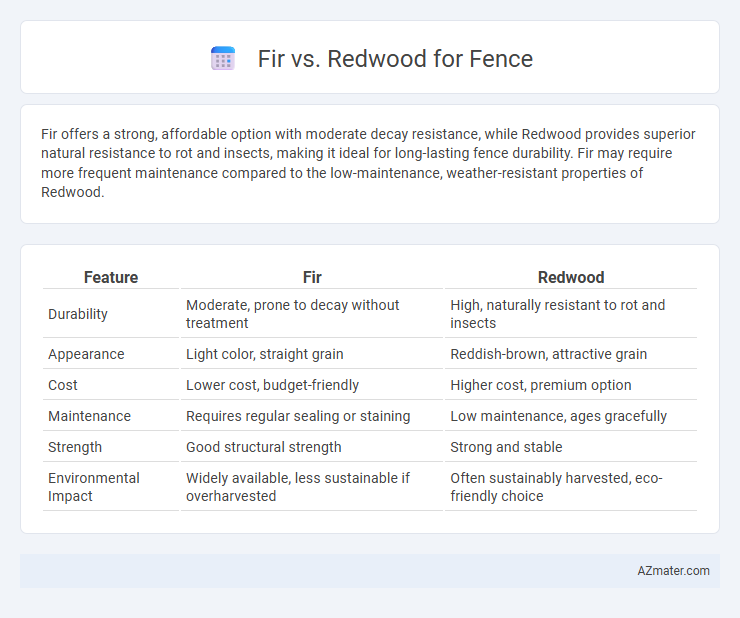Fir offers a strong, affordable option with moderate decay resistance, while Redwood provides superior natural resistance to rot and insects, making it ideal for long-lasting fence durability. Fir may require more frequent maintenance compared to the low-maintenance, weather-resistant properties of Redwood.
Table of Comparison
| Feature | Fir | Redwood |
|---|---|---|
| Durability | Moderate, prone to decay without treatment | High, naturally resistant to rot and insects |
| Appearance | Light color, straight grain | Reddish-brown, attractive grain |
| Cost | Lower cost, budget-friendly | Higher cost, premium option |
| Maintenance | Requires regular sealing or staining | Low maintenance, ages gracefully |
| Strength | Good structural strength | Strong and stable |
| Environmental Impact | Widely available, less sustainable if overharvested | Often sustainably harvested, eco-friendly choice |
Introduction: Choosing the Right Wood for Your Fence
Fir offers a cost-effective, durable option for fencing with its straight grain and moderate resistance to decay. Redwood, while more expensive, provides superior natural resistance to moisture, insects, and rot, ensuring long-lasting beauty and durability. Selecting between fir and redwood depends on budget, climate conditions, and desired fence longevity.
Fir vs Redwood: An Overview
Fir wood offers a cost-effective option for fencing with moderate durability and a straight grain that provides ease of installation. Redwood, known for its natural resistance to decay and insects, boasts exceptional longevity and a rich reddish hue that enhances aesthetic appeal. Comparing Fir vs Redwood reveals that Redwood generally outperforms Fir in terms of weather resistance and lifespan, making it ideal for long-lasting outdoor fences.
Durability and Longevity Comparison
Fir fences offer moderate durability with a lifespan of 10-15 years due to their susceptibility to rot and insect damage in moist environments. Redwood provides superior longevity, often lasting 20-30 years, thanks to its natural resistance to decay and insect infestation. Choosing redwood ensures a more durable fence that withstands harsh weather conditions and requires less maintenance over time.
Resistance to Weather and Insects
Fir wood offers moderate resistance to weather and insects but generally requires regular maintenance, including sealing and staining, to prevent decay and insect damage. Redwood provides superior natural resistance to moisture, decay, and insect infestation due to its high tannin content, making it a durable choice for long-lasting fence construction. Choosing redwood can reduce the need for chemical treatments and maintenance compared to fir in outdoor environments.
Maintenance Requirements
Fir fences demand regular maintenance, including frequent painting or staining to prevent rot and insect damage due to their softer wood composition. Redwood offers superior natural resistance to decay and pests, significantly reducing upkeep efforts and extending the fence's lifespan. Choosing redwood can lower long-term maintenance costs and provide a more durable, weather-resistant fencing solution.
Aesthetic Differences: Color and Grain
Fir features a light, pale yellow to reddish-brown color with a relatively straight, uniform grain that offers a clean and consistent appearance for fences. Redwood displays a rich, deep reddish-brown hue with prominent, irregular grain patterns, providing a warm, natural, and rustic aesthetic. The vibrant, varied tones of redwood make it a popular choice for visually striking fences, while fir's subtle coloration suits more understated designs.
Cost Analysis: Upfront and Long-term Expenses
Fir fencing offers a lower upfront cost compared to Redwood, making it a budget-friendly option for homeowners. Redwood fences have higher initial expenses due to their premium durability and natural resistance to decay, reducing long-term maintenance and replacement costs. Over time, Redwood's longevity and minimal upkeep can result in greater cost efficiency despite the initial investment.
Environmental Impact and Sustainability
Fir wood, commonly sourced from fast-growing plantations, offers a renewable option with a relatively low carbon footprint due to its rapid regrowth rate. Redwood, harvested primarily from old-growth forests, has higher durability but raises concerns about deforestation and habitat loss, impacting biodiversity negatively. Choosing fir for fencing promotes sustainable forestry practices and reduces long-term environmental impact compared to redwood.
Ease of Installation
Fir wood offers excellent ease of installation for fencing due to its straight grain and consistent texture, allowing for smooth cutting and nailing. Redwood is slightly denser but remains relatively easy to work with, providing durability while maintaining manageable handling during installation. Both woods are lightweight compared to other hardwoods, making them ideal choices for quicker fence assembly.
Best Uses: Which Wood Suits Your Needs?
Fir wood, known for its strength and affordability, is best suited for structural fence components and painted fences where durability and cost-effectiveness are priorities. Redwood offers natural resistance to decay and insects, making it ideal for decorative fences and outdoor privacy screens that require low maintenance and a rich, natural appearance. Choosing between Fir and Redwood depends on your fence's exposure conditions and desired aesthetic, with Fir favored for budget-friendly projects and Redwood preferred for long-lasting beauty in harsh environments.

Infographic: Fir vs Redwood for Fence
 azmater.com
azmater.com